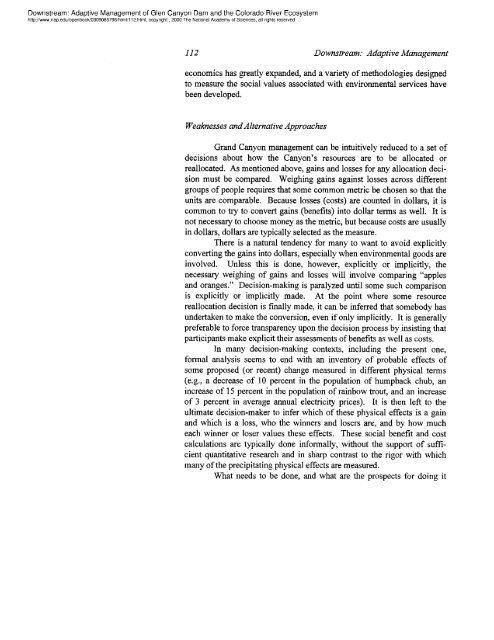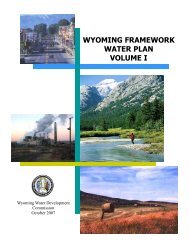Glen Canyon Dam adaptive management program. - Living Rivers
Glen Canyon Dam adaptive management program. - Living Rivers
Glen Canyon Dam adaptive management program. - Living Rivers
You also want an ePaper? Increase the reach of your titles
YUMPU automatically turns print PDFs into web optimized ePapers that Google loves.
Downstream: Adaptive Management of <strong>Glen</strong> <strong>Canyon</strong> <strong>Dam</strong> and the Colorado River Ecosystem<br />
http://www nap.edu/openbook/0309065798/html/l12.html, copyright, 2000 The National Academy of Sciences, all rights reserved<br />
112 Downstream: Adaptive Management<br />
economics has greatly expanded, and a variety of methodologies designed<br />
to measure the social values associated with environmental services have<br />
been developed.<br />
Weaknesses and Alternative Approaches<br />
Grand <strong>Canyon</strong> <strong>management</strong> can be intuitively reduced to a set of<br />
decisions about how the <strong>Canyon</strong>'s resources are to be allocated or<br />
reallocated. As mentioned above, gains and losses for any allocation decision<br />
must be compared. Weighing gains against losses across different<br />
groups of people requires that some common metric be chosen so that the<br />
units are comparable. Because losses (costs) are counted in dollars, it is<br />
common to try to convert gains (benefits) into dollar terms as well. It is<br />
not necessary to choose money as the metric, but because costs are usually<br />
in dollars, dollars are typically selected as the measure.<br />
There is a natural tendency for many to want to avoid explicitly<br />
converting the gains into dollars, especially when environmental goods are<br />
involved. Unless this is done, however, explicitly or implicitly, the<br />
necessary weighing of gains and losses will involve comparing "apples<br />
and oranges." Decision-making is paralyzed until some such comparison<br />
is explicitly or implicitly made. At the point where some resource<br />
reallocation decision is finally made, it can be inferred that somebody has<br />
undertaken to make the conversion, even if only implicitly. It is generally<br />
preferable to force transparency upon the decision process by insisting that<br />
participants make explicit their assessments of benefits as well as costs.<br />
In many decision-making contexts, including the present one,<br />
formal analysis seems to end with an inventory of probable effects of<br />
some proposed (or recent) change measured in different physical terms<br />
(e.g., a decrease of 10 percent in the population of humpback chub, an<br />
increase of 15 percent in the population of rainbow trout, and an increase<br />
of 3 percent in average annual electricity prices). It is then left to the<br />
ultimate decision-maker to infer which of these physical effects is a gain<br />
and which is a loss, who the winners and losers are, and by how much<br />
each winner or loser values these effects. These social benefit and cost<br />
calculations are typically done informally, without the support of sufficient<br />
quantitative research and in sharp contrast to the rigor with which<br />
many of the precipitating physical effects are measured.<br />
What needs to be done, and what are the prospects for doing it
















